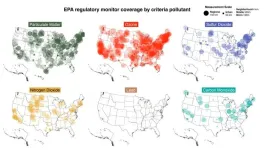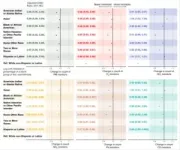(Press-News.org)
U.S. Environmental Protection Agency (EPA) air quality monitors are disproportionally located in predominately white neighborhoods, according to University of Utah research. The EPA’s network consistently failed to capture air quality in communities of color across six major pollutants, particularly lead and sulfur dioxide, followed by ozone and carbon monoxide.
EPA regulatory monitors are the key data source driving decisions about pollution reduction, urban planning and public health initiatives. Without equal monitor distribution, the data may misrepresent pollution concentrations, leaving marginalized groups at risk.
“It’s the question behind the question. Researchers, policymakers, we all use air quality data, but whose air is it measuring?” said Brenna Kelly, doctoral student at the U and lead author of the study. “Even though this data is of really high quality, that doesn’t mean that it’s high quality for everyone.”
Research has shown that marginalized communities have the highest rates of exposure to air pollution, but the studies assumed that the data represented all neighborhoods equally. This study is the first to assess disparities in the monitors themselves for all U.S. Census groups, on a neighborhood scale. While disparities existed for all non-white groups, the largest were for Native Hawaiians and other Pacific Islanders, followed by American Indian and Alaska Native populations.
Air quality research and analysis often require artificial intelligence (AI) tools to process the massive volumes of data. While bias in AI algorithms is well-known, the study exemplifies another ethical issue for big-data users—the chance that the datasets themselves are inherently biased.
“If there was a disparity for just one type of monitor, it could conceivably be accidental or just poor design,” said coauthor Simon Brewer, associate professor of geography and executive committee member of the U’s ONE-U Responsible AI Initiative. “The fact that it's a consistent pattern across all pollutants suggests that the decision-making process needs to be looked at carefully—these monitors are not being distributed equitably.”
The study was published in journal JAMA Network Open on Dec. 4, 2024.
Air quality is hyperlocal and can change dramatically from street to street. The authors mapped monitor locations and neighborhood demographics to the census-block level, one of the U.S. Census Bureau’s smallest units for residential patterns. Using the EPA Air Quality System Regulatory Monitoring Repository, they identified monitors for six major air pollutants dangerous to human health—lead, ozone, nitrogen dioxide, sulfur dioxide, carbon monoxide and particulate matter. They used the 2022 American Community Survey Census to estimate the racial and ethnic composition for every census-block in the country. Adjusting for population size, the researchers found systemic monitoring disparities for each criteria pollutant. Relative to the white non-Hispanic population, all groups were associated with fewer lead, ozone, nitrogen dioxide and particulate matter monitors.
Kelly got curious about the EPA’s air quality monitoring network while pursuing her doctoral research in population health sciences, focusing on the risks of air pollution exposure to pregnant people. Epidemiology research identifies the factors that contribute to diseases within a population. Until now, there’s been an underlying assumption that the data represents air quality problems everywhere equally, she explained.
“It's not just that we're missing one pollutant type for one group, it's that we understand less about everything for all these groups. That's concerning,” Kelly said. “If I want to relate air pollution exposure to a disease, I need to measure it well. If I have a better understanding of air quality for one group of people, that’s going to produce biased results.”
Air quality and population health are just two of many fields grappling with the challenges of using big data and AI responsibly. The One-U Responsible AI Initiative is the U’s recent effort to bring together experts to develop best practices.
“This study is particularly relevant in an increasingly data-driven society. One of the goals of the Responsible AI Initiative is to study the fair application of artificial intelligence methods,” Brewer said. “Our results suggest that biases in the data may be as important to consider as any algorithmic bias.”
Other authors include University of Utah researchers Tracy Onega of Population Health Sciences, Thomas Cova of the School of Environment, Society and Sustainability and Michelle Debbink of the Departments of Obstetrics and Gynecology.
END
For the second year in a row, Mayo Clinic physician Dr. Parminder Singh has organized a team of riders to raise funds for cancer research while tackling the 32- or 62-mile routes of the Tour de Scottsdale.
Singh is a clinical trialist with SWOG Cancer Research Network, a world-renowned organization leading cancer studies across the US and beyond. SWOG trials have led to the approval of 14 cancer drugs, changed more than 100 standards of cancer care, and saved more than 3 million years of human life.
Team Hope’s youngest rider is 11-year-old Misha Rajpal who will take on the full, ...
Autoimmune diseases, which are estimated to affect more than 15 million people in the U.S., occur when the body responds to immune-system false alarms, and infection-fighting first responders are sent out to attack threats that aren’t there. Scientists have long understood how the false alarms get triggered, but the second step of dispatching the immune response has been a mystery.
Now, scientists at Washington University School of Medicine in St. Louis and the Perelman School of Medicine at the University of Pennsylvania ...
TALLAHASSEE, Fla. — Florida State University chemists have created a machine learning tool that can identify the chemical composition of dried salt solutions from an image with 99% accuracy.
By using robotics to prepare thousands of samples and artificial intelligence to analyze their data, they created a simple, inexpensive tool that could expand possibilities for performing chemical analysis. The work was published in Digital Discovery.
“We are living in the age of artificial intelligence and big data,” ...
Fan Zhang, PhD, sees artificial intelligence as a pathway to finding an effective way to combat an intractable enemy: rheumatoid arthritis.
Zhang is an assistant professor in the University of Colorado Department of Medicine’s Division of Rheumatology and also is affiliated with the Department of Biomedical Informatics on the CU Anschutz Medical Campus. She recently received a highly competitive grant from the Arthritis Foundation to further her work in harnessing AI to better predict the onset of rheumatoid arthritis (RA) in particular patients, ...
BALTIMORE, March 18, 2025— A new study led by Kennedy Krieger Institute’s Center for Autism Services, Science and Innovation (CASSI) finds that a community-based screening model is helping children receive autism diagnoses faster, particularly in underserved communities.
The research, published in Pediatric Investigation, highlights how the Rapid Interactive Screening Test for Autism in Toddlers (RITA-T) is making early autism identification more accessible for families facing barriers to care. RITA-T is a quick, interactive tool that assesses developmental skills often delayed in autism, such as social engagement, ...
Women with blood pressure levels in a range considered clinically normal during pregnancy but no mid-pregnancy drop in blood pressure face an increased risk of developing hypertension in the five years after giving birth. These women—about 12% of the population studied—would not be flagged as high-risk by current medical guidelines, but the new findings could help identify them as candidates for early intervention. The findings were just published in the Journal of the American College of Cardiology: Advances.
Funded in part by the National Institutes of Health, researchers collected data on blood pressure and other health factors ...
Since becoming only the second Alzheimer’s-modifying drug to gain American Federal Drug Administration approval in 2023, sales of lecanemab, known by its brand name Leqembi, have risen steadily, reaching $87-million USD in the last quarter of 2024.
In its Phase 3 clinical trial, lecanemab slowed cognitive decline by 27 per cent overall, yet one subset of data suggested little to no benefit in females, though the cause of the difference was not clear. An FDA committee voted unanimously that the Phrase 3 trial verified the clinical benefit of lecanemab. Even so, several follow-up papers focused on the trial’s apparent sex difference result to cast doubt on ...
TAMPA, Fla. (Mar. 18, 2025) — Moffitt Cancer Center researchers have discovered a promising new vaccine strategy for treating a specific type of breast cancer. The innovative approach targets human epidermal growth factor receptor 2-positive, estrogen receptor-negative (HER2-positive, ER-negative) breast cancer and has shown encouraging results in a recent pilot study. Published in npj Breast Cancer, the study combined the HER2-targeting dendritic cell vaccines with standard chemotherapy, demonstrating both safety and positive response rates.
The study enrolled 30 patients with stage 2 and stage 3 HER2-positive, ...
Toronto - Despite a very uncertain economic climate, investors can at least feel confident that audited financial reports are more reliable thanks to the spread of international standards.
New research led by a researcher at the University of Toronto’s Rotman School of Management shows that the quality of financial audits increasing in countries which have adopted the International Standards on Auditing, or ISA, issued through the International Federation of Accountants, the accounting profession’s worldwide body.
“We show improvement in audit quality, on average,” said researcher Ole-Kristian Hope, the Deloitte Professor of Accounting at the Rotman School. However, ...
Internal displacement in Syria was used by the Assad regime to reshape the country’s political and social landscape, a new study shows.
The forceful movement of people was systematically employed alongside indiscriminate violence, the research says.
This was not just a consequence of war, but a strategy to depopulate key areas and repopulate them to create new political and social realities. This tactic extended the impact of displacement beyond the immediate conflict, embedding it as a long-term political tool with lasting post-war ...






